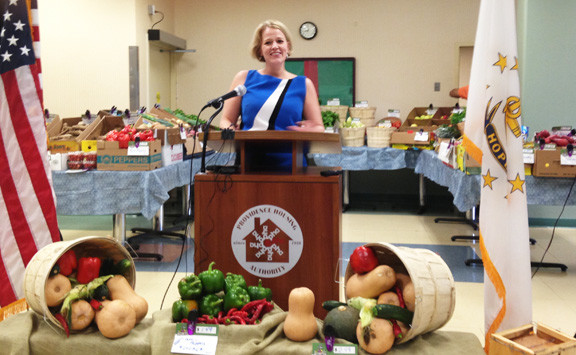Bringing the market for healthy, affordable foods to the neighborhoods
New Food on the Move program is the first of its kind in the nation, offering to double the value of SNAP purchases spent on fruits and vegetables
PROVIDENCE – When it comes to food, there are many ways to map out Rhode Island: as a culinary valley where there are a cornucopia of farm-to-table restaurants, gourmet food trucks, and chef-owned eateries that compete every year for James Beard awards; as a river of food swamps made up of fast-food chain restaurants that line both sides of commercial strips such as Reservoir Avenue in Cranston; or as an archipelago of food deserts, those islands of low-income urban neighborhoods without ready access to fresh, healthy and affordable food.
An overlay of these different maps of food in Rhode Island would not, in and by itself, produce any surprises, except to identify how difficult it can be for those islands of low-income urban neighborhoods to access fresh, healthy and affordable food while, at the same time, how easy it is for them to partake of retail fast-food in the food swamps.
Such a map could also be expanded to show the connection between food and health outcomes, between low-income neighborhoods and the disparities in health disparities, and how the lack of access to healthy, affordable fruits and vegetables can contribute to higher levels of obesity and other diet-related diseases, such as diabetes and heart disease.
That connection has been front-and-center in two new affordable housing developments, one in Pawtucket that will have FarmFreshRI as a first-floor tenant, and another in the West End of Providence, where some 50 new apartments are being built in a $15 million development nearby urban farming spaces. [See link to ConvergenceRI story below.]
In addition, a new program, Food on the Move, which builds on the success of a “Fresh To Market” mobile market program, developed by Gemma Gorham, project director of the Institute of Community Health at Brown University in partnership with researcher Kim Gans, has been launched in Rhode Island.
The program brings fresh fruits and vegetables and creates a market where residents live. And, as part of the program, SNAP recipients get to double their purchasing power at the Food on the Move market: for every $1 dollar they use to buy fresh produce, they get another $1 to spend at the market.
That doubling of SNAP benefits is underwritten by a federal grant of $100,000 from the U.S. Department of Agriculture, with the support and advocacy of Sen. Jack Reed.
At Kilmartin Plaza
The Food on the Move van was parked at the entrance of Kilmartin Plaza, the Providence Housing Authority high-rise apartment building at 160 Benedict St., serving low-income and disabled elderly residents, where the new mobile market was officially inaugurated on Sept. 11.
On hand to mark the festivities were Sen. Jack Reed, Providence Mayor Jorge Elorza, First Gentleman Andy Moffit, and Dr. Nicole Alexander-Scott, director of the R.I. Department of Health.
Dr. Amy Nunn, the executive director of the R.I. Public Health Institute and an assistant professor in the Alpert Medical School and the School of Public Health at Brown University, served as the emcee; she later joined in with residents to shop at the market.
Nunn’s remarks provided a comprehensive overview of the programs and its goals. She first gave credit to Kim Gans and Gemma Gorham as the originators of the program and the clinical trials that proved the value of a mobile marketplace to provide fresh fruits and vegetables.
The clinical trials, Nunn said, found that bringing local produce to residents proved to be a really effective way to address food insecurity.
“About 15 percent of Rhode Islanders experience food insecurity on any given day,” she said. “We have the highest rates of food insecurity in New England.”
One of the tragic health consequences, Nunn continued, was that a lot of people who experience food insecurity were also obese – what she termed a big health conundrum.
“It’s something that this program has been trying to address and trying to understand scientifically for five years,” Nunn said. “We know that bringing fresh produce to where people live and where they work can really help address a lot of these problems.”
Nunn continued: “What we found was that when you subsidize the price of fruits and vegetables, and you make them easy to buy, that people will in fact eat more product.”
According to Nunn, there were a lot of myths about why people are food insecure, and why they are obese. “One of the big challenges with obesity is that people don’t have access to healthy fruits and vegetables in the neighborhoods where they live.”
There are a lot of food swamps and food deserts in Rhode Island, Nunn continued. “The aim of this project is to bring service to people where they live, something we know that has proven to be very effective, particularly for the elderly.”
One of the things that most exciting about the new Food on the Move program, Nunn stressed, was that it created double the value for SNAP recipients. “If you spend one dollar at our market, it will be worth two dollars,” she said.
Nunn lauded Reed for his advocacy efforts in obtaining the federal grant.
Finally, Nunn said she wanted to remind people that Food on the Move was a market-based solution. Beyond the R.I. Food Bank, Nunn said that it was important to create a market-based solution, where people were able to buy fresh produce in the communities where they live and work.
“This is a model for the rest of the county, the only one of its kind, but one that has the potential to be replicated across the country. The federal government is watching this program with keen interest.”






